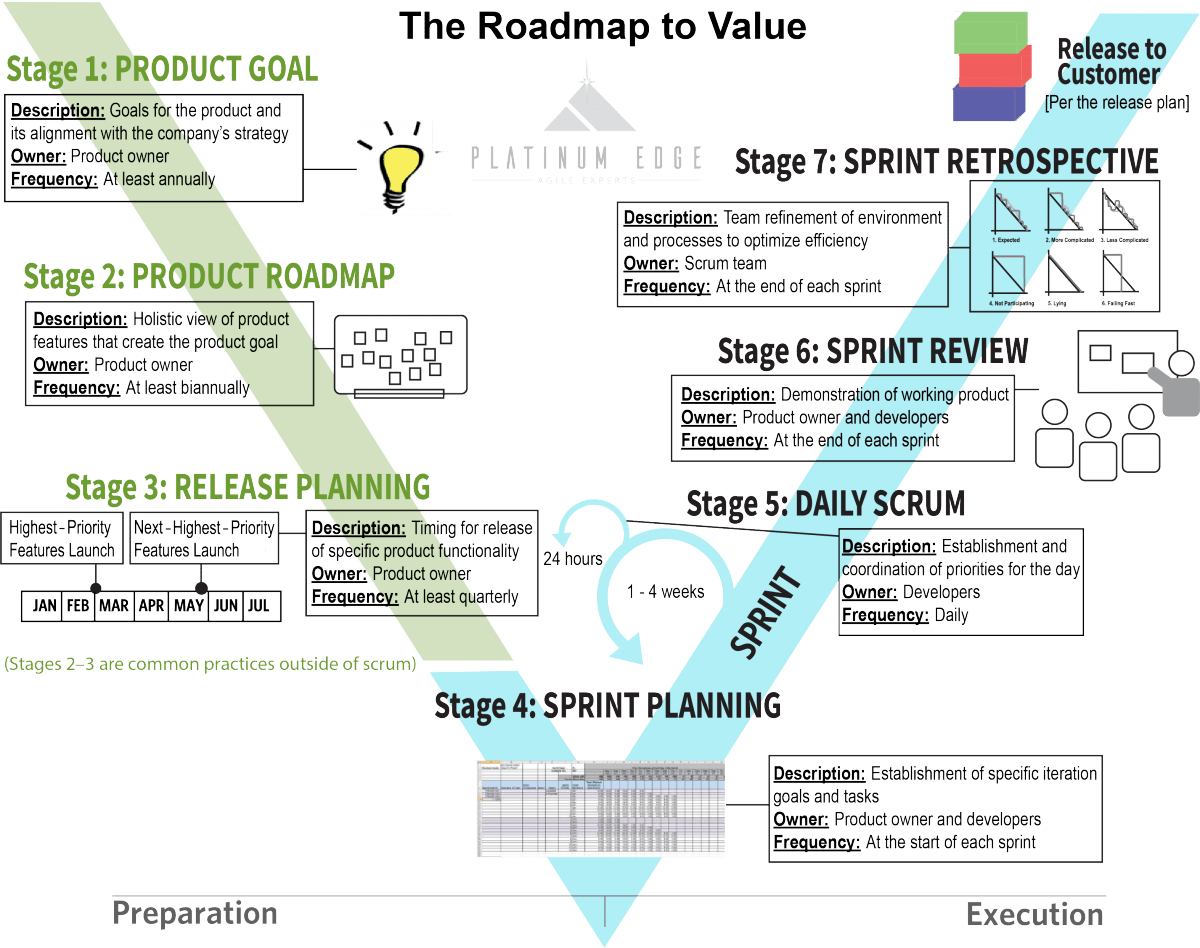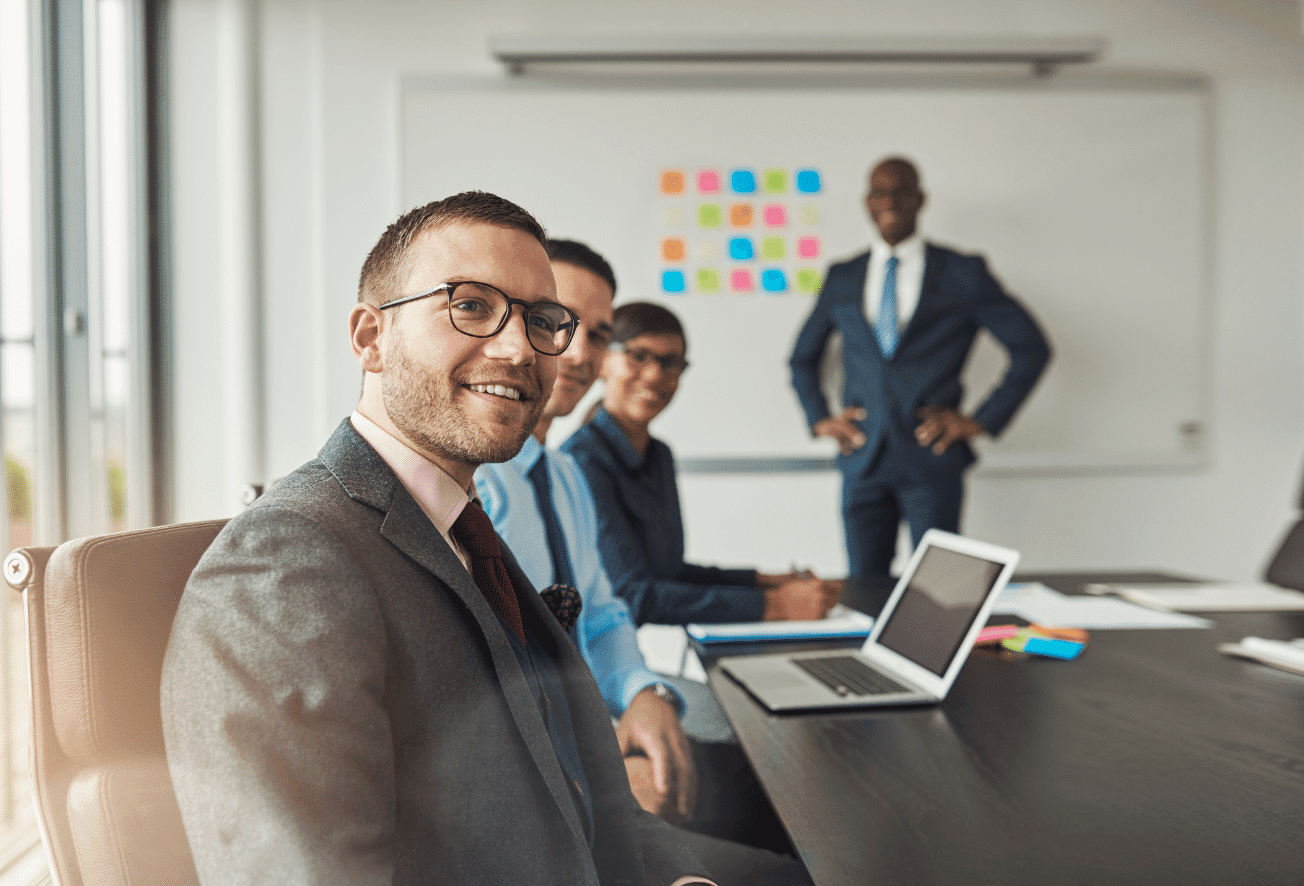Transforming organizations is an intriguing topic of discussion. Leaders are continually looking for ways to maximize the value created for customers and shareholders, believing transformational business agility and more effective ways of working are possible. Agile transformations can be difficult because they challenge the very foundation of organizations. They disrupt the culture, habits, policies, and technical debt accrued over years of investment.
We’ve found that nothing will move an agile organization forward faster or more effectively than an agile transition team (ATT).
ATTs are essential for transformation success because scrum teams’ maximum pace is determinable by the environment in which they’re working. The ATT’s role is to create and improve the organizational environment. Agile transformations require enduring, deeply rooted change that only an ATT can provide.
What is an agile transition team?
The ATT is a scrum team responsible for implementing the structural, organizational, and process changes to make agile techniques successful. They take an organizational level view of the transformation. Staffed with a cross-functional team of executives who create policy and own status quo, they build, prioritize, and refine a backlog from both an agile maturity roadmap and organizational impediments. They run as a scrum team to structurally move the organization to become more agile while setting the example of agility and servant leadership.
Why are they important?
The ATT owns the vision for enabling the organization to become more agile and is responsible for its maturity. During an agile assessment of the organization’s current processes, roles, and structure, the ATT creates an adoption strategy and agile maturity roadmap. The ATT follows the roadmap to lead the transformation.
Empowered to make necessary changes, they remove organizational obstacles preventing the scrum teams from reaching their potential. They structurally move the organization to become more agile by transparently inspecting and adapting their team and the organization. The ATT promotes executive sponsorship for the transformation and helps other leaders to do so as well. In summary, ATTs improve the odds of transformational success.
Who should be on the ATT?
Organizations are most successful at agile transformation when they recognize it requires change and collaboration across the organization, not just within IT or product management. The most effective ATTs are stable, cross-functional teams of executives from all business domains: operations, information technology, human resources, finance, etc.
These highly influential individuals become organizational change champions. Like any scrum team, they include a product owner, “development team” members (people who will make the organizational changes), and a scrum master. Having the support of a professional agile coach or mentor for the team is essential, as well.
Jeff Sutherland, one of the co-authors of the Agile Manifesto and a co-creator of scrum, recommends staffing the ATT with policy changers, check writers, motivators, agile champions, HR, and legal team members. Regardless, you’ll want a team with leaders who have inherent servant leadership tendencies. Your agile coach can help you identify potential ATT members as part of the agile assessment.
The ATT sets the pace of the transformation. They learn that the more time they invest in the transformation, the better it progresses. Initially, these busy executives struggle to be fully dedicated, as required of typical scrum team members. However, as they work together, they find balance.
For each ATT sprint, they implement organizational improvements as their increment. Having each team member trained and certified in scrum is a critical prerequisite for anyone on the ATT. We recommend essential agile training courses, such as Certified Scrum Product Owner (CSPO) or Certified Scrum Master (CSM), and Certified Agile Leadership (CAL) for all ATT members.
The ATT also identifies stakeholders to support them. Stakeholders selected are the people the ATT trusts to represent the organization at various levels, domains, and customers. Stakeholders should include the pilot scrum team(s), future scrum team members, and c-suite executives. Stakeholder engagement and feedback is crucial to the transformation’s success.
When should you start an ATT?
After the assessment, start the ATT next. This is because the ATT creates the foundational, organizational environment to help scrum teams thrive. In true agile form, the ATT will be working initially on the highest value and highest risk backlog items. Delaying the ATT holdups addressing the most valuable and risky opportunities.
How should they work?
The most effective ATTs use the Roadmap to Value. The Roadmap to Value outlines the typical approach for creating value aligned to a customer-focused vision and roadmap.

They begin by setting a clear vision for how the ATT’s efforts will benefit the customer. The agile maturity roadmap supports the vision, then adjusts based on reality. Validation of the vision occurs annually and semi-annually for the roadmap. ATTs also set release goals (or they may prefer to call them “phase goals” since they don’t release software). They continually monitor, inspect, and adapt their overall plan.
The ATT uses scrum, including the three scrum roles, three scrum artifacts, and five scrum events. They maintain a backlog and hold sprint planning, daily scrums, sprint reviews, and sprint retrospectives. Daily scrums for these busy executives may not always be feasible, but the more frequently they inspect and adapt throughout the sprint, the more effective their team becomes. ATTs should expect to maintain a constant, sustainable pace indefinitely.
Another helpful approach ATTs use as the agile footprint expands is to enable members to engage closely with new pilot scrum teams. ATTs make attending team events a priority. They unexpectedly show up for a daily standup or sprint planning, particularly if the team’s burndown is trending off. Alternatively, they drop by, careful not to disrupt the team, and check the team’s task board (or virtual collaboration board).
Focused inspection of the team’s increment during the sprint review, then contributing to the team’s decisions about how to adapt to the feedback go a long way. After each sprint retrospective, they follow-up with the team to see if there are any organizational impediments to resolve. Effective ATT members also actively participate in the scrum team’s onboarding, visioning, roadmapping, and release planning. The scrum team appreciates the ATT’s support.
The ATT members benefit too by gaining a deeper understanding of the team’s challenges, informing their backlog prioritization, particularly impediments actively looking for opportunities to help.

The ATT’s sprint review is a good opportunity to capture feedback on organizational changes implemented to either help the organization mature or to improve the pilot scrum team’s effectiveness. They also discuss upcoming priorities. Aligning to the cadence of the pilot scrum teams is helpful for responding timely to their needs. A side benefit is the accountability model the sprint review supports of organizational leaders truly serving and working to improve teams (rather than the traditional vice versa of command and control).
Lastly, building organizational capability is a key objective of the ATT. Not only do they ensure proper agile training is available to the scrum teams, but they are somewhat selective in the organizational impediments they choose to address. They are careful not to address an impediment that the scrum team can deal with themselves. If they do pull in an organizational impediment, they strive to include the team in its resolution through mentoring or shadowing. The approach builds team and scrum master capability.
According to the latest research performed by the Scrum Alliance in partnership with Forbes, the top organizational changes addressed by most ATTs are:
- Hire a third-party consultant to help them become more agile
- Introduce an agile mindset as part of the culture
- Create incentives to promote agility
- Reorganize work processes
- Reorganize reporting structures
- Train/employ workforce to lead agile processes
- Create a group/position responsible for agility
- Introduce a flatter structure
Without an ATT
Recently, we worked with a client that decided to delay the creation of their ATT. Their first pilot scrum team started working with the help of middle management. They co-located the team and gave team members a brief agile essentials refresher course. The team then began to apply, as best they could, the new scrum roles and framework.
The team did not feel supported in their journey and often wondered why their leaders pushed them to practice scrum, while other teams didn’t. Organizational impediments such as their gate-ridden system development life-cycle (SDLC), release and change management policies, and architectural constraints remained unaddressed.
Middle managers soon decided their old way of working was better and are now making plans to dismantle the pilot team after only a few months. Middle managers concluded with the costly decision that “scrum” was not a good fit for their organization as they “tried it, and it failed.”
Transformation with an ATT
Conversely, another recent client started their transformation by building an IT-focused ATT (as they struggled with initial business support). The ATT immediately got to work defining their first pilot team. They arranged for training themselves and the pilot team members. They co-located the pilot team as best they could and began addressing a backlog of organizational impediments identified during the assessment.
After their first year, they had turned around a failing flagship project and changed their hierarchical culture to empowered, self-organizing teams. Instead of moving people to staff projects, they began collaboratively flowing projects to stable teams. They changed the organization to address regression test automation technical debt a priority, enabling all teams to improve their velocity.
Many offshore team members moved onshore. They reduced work in progress, removing organizational logjams. The atmosphere changed from fearful, date-driven change resistance to courageous, value-driven resilience.
The ATT learned first-hand the importance of
- Co-located (or geographically close) teams changing their organization’s hiring strategy
- the agile manifesto, principles, and scrum values
- Servant leadership effectiveness
- Building capability
- Challenges of a backlog, forecasting, swarming, and delivering incremental value frequently
The membership of the ATT changed in year two to be more balanced across the business functions. Their vision also shifted from focusing on embedding agile fundamentals to building organizational capability for their “customer’s competitive advantage.” (Principle 2)
C-suite executives became more engaged in the transformation as well due to the ATT’s influence. One team member remarked that he felt his experience on the ATT was “the first time when all of the business functions actually worked together toward a common goal.”
As for the ATT team members themselves, the Finance VP development team member later became the organization’s CFO. One of the IT VPs is now the CIO. The team’s scrum master is leading the new Agile Center of Excellence (ACE). All the team members would agree that their experience as a member of the ATT was an unparalleled, career-building opportunity.
We’re in the transformation business
The most effective, enduring transformations occur when supported by an engaged, agile transition team. A team of leaders who learn to lead the transformation themselves (beyond just writing a check for consultants to lead – read “bad idea.”), ATTs that start early with a clear vision, an agile maturity roadmap, effective staffing, and use scrum to inspect and adapt transparently are unstoppable. The maximum pace of scrum teams is determinable by the environment in which they’re working. Use an ATT, supported by our professional agile coaching, to successfully transform your organizational environment for better results.
At Platinum Edge, we’re in the transformation business. Let us help you leverage our top-rated assessment, recruiting, training, and coaching and mentoring.
Contact us. We can help.


